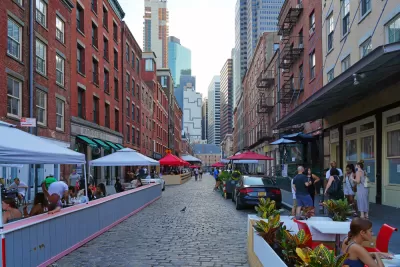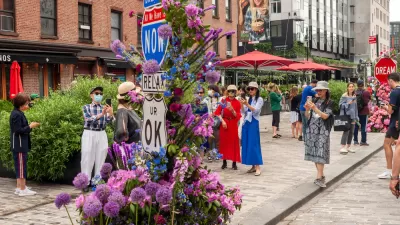Imagining a post-car (or car-lite) New York City.

Henry Grabar writes:
In the year since the pandemic shut down New York City, momentum has been building around the idea that the city ought to take back more space from cars. Especially while it’s still in partial hibernation.
The various phases of the pandemic have given repeated occasions for New Yorkers to witness what a city can be without cars filling every space to the brim and beyond.
"We no longer had to imagine a city that gave less of itself to automobiles; we were suddenly, sort of accidentally, living in it," write Grabar.
The Big Apple's low car ownership rates and high population density make it the natural candidate to push the experiment even further, according to Grabar, and one safe streets organization, Transportation Alternatives, has recently published a report called 25x25 that imagines the possibilities of closing one-quarter of the city's streets to automobiles by 2025.
Grabar lists some of the potential outcomes envisioned by the report, like 1,000 miles of pedestrian streets, a car-free block available for play in front of every public school in the city, 500 miles of bus lanes and 40 miles of busways, and 5.4 million square feet of street space available to local businesses and nonprofits, among many, many other possibilities.
The kicker for Grabar's take on the report: New York has the most expensive land in the world—more of it should do something other than store cars.
FULL STORY: What New York Could Do if It Took a Quarter of Its Roads Away From Cars

Alabama: Trump Terminates Settlements for Black Communities Harmed By Raw Sewage
Trump deemed the landmark civil rights agreement “illegal DEI and environmental justice policy.”

Study: Maui’s Plan to Convert Vacation Rentals to Long-Term Housing Could Cause Nearly $1 Billion Economic Loss
The plan would reduce visitor accommodation by 25% resulting in 1,900 jobs lost.

Planetizen Federal Action Tracker
A weekly monitor of how Trump’s orders and actions are impacting planners and planning in America.

Wind Energy on the Rise Despite Federal Policy Reversal
The Trump administration is revoking federal support for renewable energy, but demand for new projects continues unabated.

Passengers Flock to Caltrain After Electrification
The new electric trains are running faster and more reliably, leading to strong ridership growth on the Bay Area rail system.

Texas Churches Rally Behind ‘Yes in God’s Back Yard’ Legislation
Religious leaders want the state to reduce zoning regulations to streamline leasing church-owned land to housing developers.
Urban Design for Planners 1: Software Tools
This six-course series explores essential urban design concepts using open source software and equips planners with the tools they need to participate fully in the urban design process.
Planning for Universal Design
Learn the tools for implementing Universal Design in planning regulations.
Caltrans
Smith Gee Studio
Institute for Housing and Urban Development Studies (IHS)
City of Grandview
Harvard GSD Executive Education
Toledo-Lucas County Plan Commissions
Salt Lake City
NYU Wagner Graduate School of Public Service





























